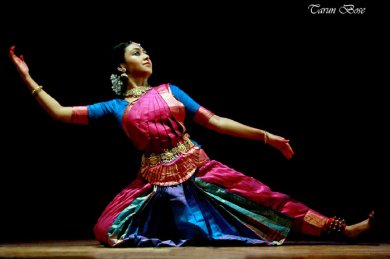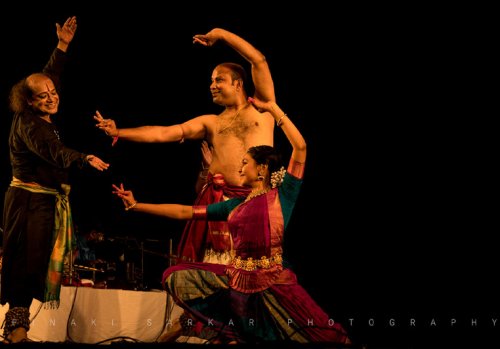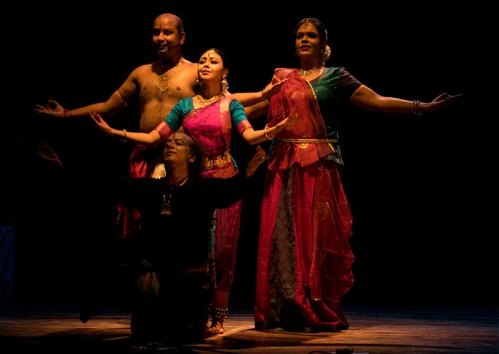
|   |

|   |
 e-mail: ukb7@rediffmail.com A Kathak-Bharatanatyam jugalbandi Photos: Tarun Bose / Pinaki Sarkar Photography September 13, 2018 Aseembandhu Bhattacharya and Rajdeep Banerjee are both established names in the Kolkata dance scene, as young gurus in Kathak and Bharatanatyam respectively, running their institutions 'Upasana Centre for Dance' for 26 years and 'Parampara' for 18 years now. Aseembadhu had an early grooming in Jaipur gharana from guru Susmita Mishra, continuing studies in Rabindra Bharati University. He was later trained by Pt. Birju Maharaj in Lucknow gharana. Rajdeep was initially trained in Bharatanatyam under Ambali Praharaj and then under Ganga Thampi of Chennai, a stalwart choreographer and performer of Kalakshetra style. It was quite creditable for them to get together and perform a Sawal-Jawab with a great degree of improvisation from both sides. Such innovative jugalbandis among disparate forms of our classical dances are relatively rare, though - as it turned out -- this can open up imagination and mental horizons a great deal.  Sayani Chakraborty Anuranan presented on August 30 in Kolkata by Parampara (in close cooperation with Upasana) opened with a Bharatanatyam recital by Sayani Chakraborty. All of 27, Sayani turned out to be a dancer of a very high order. She was initially trained under Rajdeep and, later, very thoroughly groomed by Rama Vaidyanathan, the highly gifted young dancer of our rimes. Sayani began with a Shringara Alarippu set in raga Jog. Never projected as carnal in classical repertoire, shringara was here an attribute of the goddess Ambika smeared in the vermilion hue, invoking hymns that described the first sunrays falling on the divine idol to let her glow in crimson. This led to a well-known Tana Varnam, where Sayani used a few combinations of small jathis to visualise various form of lord Ganesha. This long item was fascinating to witness, with Sayani using the entire stage with admirable energy and perfect poise, and alternating speed and tempo with serene postures and still visage. Sayani followed with a delightful abhinaya to a Hori bhajan: Lal Gopala, gulal Gopala… in raga Vasant where the lovelorn Radha was longing to play Holi with Krishna, while admonishing him not to sprinkle colour into her eyes, which would prevent her to see her beloved. Then came an item in raag Behag, where Sayani excelled in creating the mood of downpour and the aura and sublimity of the whole universe. The entire creation with its flora and fauna rejoiced in the rains, while she explored its triumphal beauty. The finale was a composition, made famous by Pt. Jasraj: Om namah Bhagavate Vasudevaya namah … in raga Sohini. The song narrated how Krishna, raised by Vasudeva and Devaki, delighted all the gopis with his tuneful flute; how he and his companions teased their female friends and played tricks, eventually portraying his love for Radha; how Krishna was not just the incarnation of Vishnu, but also Padmanaba, Rama and Vamana; how we adore him singing the name of Vithala… A special word needs to be said for the exceptionally qualified musical accompaniment. Mridangam was by highly accomplished Shankaranarayana Swamy, while vocal support came from Pt. Jasraj's student Saptarshi Chakrabarty. Flute was by Pt. Hariprasad Chaurasia's disciple Pushpak Mukherjee, who delighted the audience by many passages of Jhala, a unique hallmark of his guru. The second half of the program featured was an invited performance by Aseembandhu, especially there to bless the young Sayani. His Kathak exposition began by invoking Advaitavada through Nirvanastotram by Shankaracharya from the 9th century and ending with the chant, Shivoham, Shivoham… This was followed by traditional Kathak, with Upaj, Uthan, Thaat of Jaipur gharana and Lucknow gharana, Amad and several Tehais in khanda jati, with admirable layakaris. Switching over to a Dhamar of 14-beats, he demonstrated Tatkars and Tehais, where his disciple (and daughter) Ranjani joined in. This was followed by an energetic Tarana from Jaipur gharana. Lastly came the 56-year-old guru's spirited presentation of an Urdu Nazm (anonymous love poem) sung as a ghazal: Teri khusbu se bhara khat ko main jelata kaise? Pyar me dube hue khat main jelata kaise? Tere hathon se likhe khat main jelata kaise?... as composed by Rajender Nath and set to music by Jagjit Singh. The dancer expressed the anguish of a separated lover, keen on preserving the feeling of love only in his innermost heart, but letting the material evidence - the sheaf of papers containing the love letters, for instance - float away in the waters. With a burning candle on a table top, the magical performance came in a darkened ambience with the agonised, whirling dancer flailing his desperate limbs and snuffing out the flickering candle light at the end. Adequate musical support came from tabla by Biswajit Pal, sarangi by Umesh Misra, sitar by Saubhik Mukherjee and vocal by Debashis Sarkar, a disciple of Ustad Ghulam Muhammad Khan. 

The last segment was the much-awaited Sawal-Jawab between Kathak and Bharatanatyam. It was in the form of a Mel Badhan between tabla and mridangam, maintaining the laya in Chaturasya Jati. The Kathak duo Aseembandhu-Ranjani and the Bharatanatyam duo Rajdeep-Sayani took turns to improvise with their respective percussion support on tabla and mridangam, and set the stage on fire with their vigorous footsteps and movements, with innovative angika and sattvika abhinaya. It was a sheer joy to watch, for example, the Kathak couple play 'pretend hockey' while the Bharatanatyam couple followed up with a 'pretend football'. Sayani's gestures and postures were particularly winsome, while Kathak, in general, seemed to carry the day - having been accustomed to improvise a lot in the usual format of traditional presentations. A very rewarding experience!  Dr. Utpal K Banerjee is a scholar-commentator on performing arts over last four decades. He has authored 23 books on Indian art and culture, and 10 on Tagore studies. He served IGNCA as National Project Director, was a Tagore Research Scholar and is recipient of Padma Shri. Post your comments Please provide your name and email id when you use the Anonymous profile in the blog to post a comment. All appropriate comments posted with name & email id in the blog will also be featured in the site. |